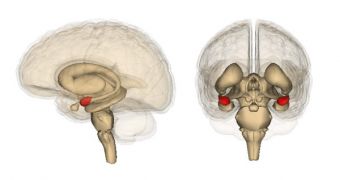A team of Iowa University have identified the part of the brain that causes people to feel fear, and this discovery could be a step forward in improving the treatment of post-traumatic stress disorder, or PTSD, as well as other anxiety conditions.
The researchers' case study was a woman who suffered from a rare condition that destroyed her amygdalae – two almond-shaped regions of the brain, and the goal of the study was to investigate the extent to which the emotions of fear depend on this brain region.
Over the past 50 years, several studies showed that the amygdala has a very important role in generating fear, from rats to monkeys, and this last research proved that it has the same role in humans too.
UI researchers observed the woman's response to many stimuli, like the most scary haunted house, horror movies, and even snakes and spiders – two of the most commonly feared animals, and concluded that the fact that she lacked the amygdala, made her feel no fear at all.
Furthermore, previous study with the same patient confirmed that she could not even identify fear expressions on other people's faces.
This discovery could lead to new approaches for PTSD treatments and related anxiety disorders, said Daniel Tranel, PhD, UI professor of neurology and psychology, director of the UI Interdisciplinary Graduate Program in Neuroscience and senior study author.
“This finding points us to a specific brain area that might underlie PTSD,” he added.
“Psychotherapy and medications are the current treatment options for PTSD and could be refined and further developed with the aim of targeting the amygdala.”
This could also mean that a safe and non-invasive way of slowing down the activity of the amygdala, could be the solution for people suffering from PTSD, suggested Justin Feinstein, lead study author and a UI doctoral student studying clinical neuropsychology.
“This past year, I’ve been treating veterans returning home from Iraq and Afghanistan who suffer from PTSD,” she added.
“Their lives are marred by fear, and they are oftentimes unable to even leave their home due to the ever-present feeling of danger.
“In striking contrast, the patient in this study is immune to these states of fear and shows no symptoms of post-traumatic stress.
“The horrors of life are unable to penetrate her emotional core; in essence, traumatic events leave no emotional imprint on her brain.”
“Taken together, these findings suggest that the human amygdala is a pivotal area of the brain for triggering a state of fear,” concluded Feinstein.
“While the patient is able to experience other emotions, such as happiness and sadness, she is unable to feel fear.
For Feinstein and Tranel, the most surprising event during the study was the woman's behavior when exposed to snakes and spiders.
She had told the researchers for many years that she hated snakes and spiders, still when she saw them at a pet store, she immediately started toughing them and explained that she was very curious.
To this study also contributed Antonio Damasio, professor of neuroscience at the University of Southern California and a longtime collaborator of Tranel, as wells as Ralph Adolphs, professor of neuroscience and psychology at the California Institute of Technology.
The funding for this study was provided by the National Institutes of Health and a National Science Foundation Graduate Fellowship.
PTSD affects over 7.7 million Americans, according to the NIMH, and a 2008 analysis by the Rand Corporation concluded that 300,000 soldiers returning from combat in the Middle East would experience PTSD.
This new study was published in the journal Current Biology.

 14 DAY TRIAL //
14 DAY TRIAL //